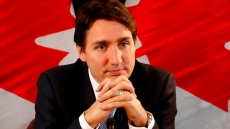TORONTO — The struggling Canadian dollar is expected to face more tough slogging ahead following Wednesday's decision by the Federal Reserve to begin raising interest rates south of the border, analysts say.
The U.S. central bank announced it was lifting its key rate by a quarter-point to a range of 0.25 per cent to 0.5 per cent, ending a seven-year period of near-zero borrowing rates.
Scott Guitard, a portfolio manager at Fiduciary Trust Canada, predicts Canada's central bank will keep its key lending rate unchanged after having cut it twice earlier this year in an attempt to stimulate the country's struggling economy.
Ian Nakamoto, director of research at 3Macs, said the different paths of the two central banks have pushed the value of Canada's dollar lower because investors look at the direction of interest rate policies when they're choosing where to put their money.
Canada's commodity-linked currency is also a less attractive option as oil prices continue to suffer while America's recovery continues to gain strength.
"Not only will you get the kicker of a rising U.S. dollar because of their economy, but the money that you have invested there will be earning a higher interest rate when interest rates go up more over the next year," he said.
Because commodities are priced in U.S. dollars, a rise in the American currency tends to depress prices because it makes them more expensive for those holding other currencies and reduces demand.
In the case of oil, the price for benchmark oil slid below US$36 a barrel Wednesday from highs above US$108 little more than a year ago.

"It's no different than going to the grocery store and buying five lemons instead of six because the price has risen," Nakamoto said.
In a research note, Scotiabank analysts Shaun Osborne and Eric Theoret said the spread between the Canadian and American interest rates should remain wide throughout 2016, especially if Canadian economic data continues to disappoint.
"It is important to note the considerable disappointment in some of the key data —specifically non-energy exports and business investment — that the Bank of Canada has expected to support domestic growth," they wrote.
Prime Minister Justin Trudeau, speaking in advance of the announcement, said it was a good sign that the American economy was seeing a resurgence, but promised to examine the challenges that a lower dollar poses for the Canadian economy.
"I think having the United States economy pick up steam is ultimately going to be good for Canada," he said.
Trudeau added that a reinvigorated U.S. economy means more opportunities for Canadian companies selling their goods south of the border.
Speaking earlier this week, Bank of Canada governor Stephen Poloz said that Canadian and American interest rate policies will continue to diverge as the gap widens between their relative economic performance.
"We just want people to understand that usually we think of the Canadian economy following the U.S. economy fairly closely, and this will be one of those places where it really doesn't," he said.
While a more valuable greenback can hurt the pocketbooks of Canadian buying American goods or vacationing down south, it is a boon for exporters who pay their costs in Canadian currency and sell their wares in U.S. dollars.






